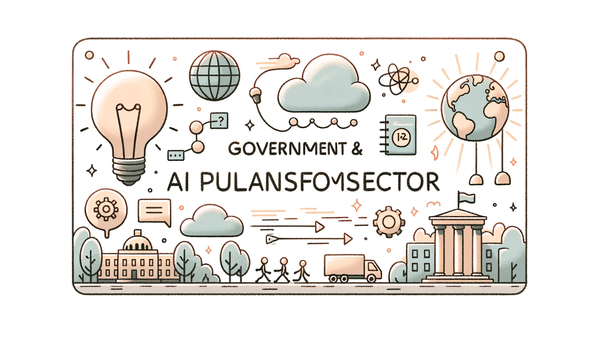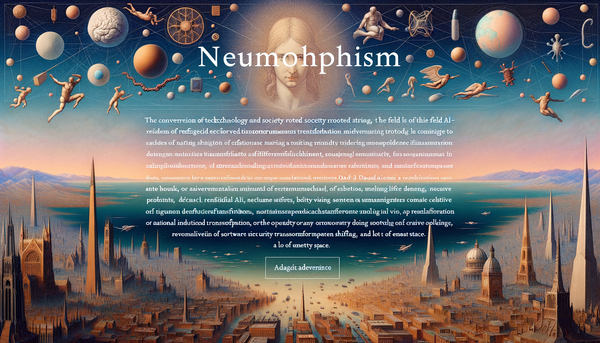Nvidia's Earnings and Apple's Bold Moves in AI
Apple’s bold moves in Texas and its staggering $500 billion AI investment, combined with FinOps’s rising influence on managing AI expenses, are reshaping the modern tech landscape—a reminder that innovation and fiscal discipline go hand in hand.
Apple’s Dual-Front AI Expansion: Fact and Ambition
Every so often, we witness a convergence of ambition and innovation that propels an industry into uncharted territory. Apple is leading one such revolution. The tech giant is not only breaking new grounds by building an advanced AI server factory in Texas (as reported by Investor's Business Daily), but it is also signaling a broader strategy to realign its manufacturing, cloud, and AI initiatives with a keen eye on both market demands and stakeholder sentiments—including those with specific political influences. This strategic presence is designed not just to boost operational capability, but also to underscore Apple's commitment to harnessing artificial intelligence as a cornerstone of its future growth.
Historically, Apple has been known for its careful integration of design, hardware, and software, and now, with its decision to dive deeper into AI infrastructure, it aims to create an ecosystem where machine intelligence enhances user experience rather than merely offering incremental upgrades. By developing a state-of-the-art facility in Texas—a hub of rapid economic growth and technological innovation—Apple is harnessing the state’s vibrant resources to foster the next generation of AI-driven products.
Alongside its physical investments, Apple is also preparing to launch initiatives like Apple Intelligence to bolster cloud security and privacy. This push further emphasizes its commitment to meeting the increasingly demanding expectations from both enterprise users and everyday consumers who are rapidly adapting to AI-driven interactions on their devices.
"The pace of progress in artificial intelligence is incredibly fast. Unless you have direct exposure to groups like DeepMind, you have no idea how fast—it is growing at a pace close to exponential." – Elon Musk
Apple’s strategy is reflective of a broader trend where technology companies are blending their operational expansion with developmental strides in AI—a practice that not only enhances technological prowess but also builds trust among all stakeholders.
Financial Operations in the Age of AI: The Rise of FinOps
In a landscape dominated by rapid technological change and soaring computational demands, managing costs associated with AI has become a sophisticated challenge. Enterprises, increasingly reliant on artificial intelligence to drive innovation, have seen traditional software expenditure spike, which puts pressure on financial departments to optimize budgets and resources. Recent insights from CIO Dive reveal that 63% of FinOps practitioners are now engaged in managing AI spending—a leap from 31% only a year ago.
This significant increase points to a paradigm shift where AI is no longer a peripheral concern but a central pillar of operations in major enterprises. The challenges come from balancing the cost structures that involve GPUs, inference costs, and tokens along with conventional CPU and memory expenses. The need for robust financial choreography is more essential than ever, as companies diversify investments over SaaS, private clouds, and traditional data center infrastructure.
Take, for example, large cloud service providers such as AWS, Google, and Microsoft who not only deliver generative AI services but also create complexities in billing and licensing models. Enterprises are responding by ramping up their FinOps initiatives to maintain fiscal discipline while ensuring innovation is never stifled by cost constraints. This approach—judicious spending paired with strategic financial governance—could be key to sustaining long-term technological dynamism and business growth.
Moreover, these financial practices provide a structured framework for innovation, ensuring initiatives like Apple’s new AI server factories and digital infrastructure investments can be executed without the financial frailties of overspending. It’s a delicate balance between fueling innovation and maintaining the economic backbone necessary for sustainable expansion.
Investing in the Future: Apple’s $500 Billion AI Bet
As if establishing a groundbreaking facility in Texas wasn’t enough, Apple is doubling down on its ambitions with an eye-watering $500 billion investment over the next four years to accelerate its AI capabilities. According to details covered in a CIO Dive report, this investment is earmarked to build a colossal 250,000-square-foot server manufacturing hub in Houston, launching by 2026 to empower its growing needs in AI-driven cloud computing.
This vast financial commitment is a clear message to investors, competitors, and the tech community at large: innovation in AI is non-negotiable. With additional plans to enhance its data centers in North Carolina, Nevada, and other strategic locations, Apple is set on a course that will provide it with the computational muscle needed to compete against industry titans like Google and Alibaba.
This surge in AI investment is not purely about building physical assets; it reflects a broader strategy to integrate advanced AI capabilities across its ecosystem. Apple Intelligence is expected to amplify security, privacy, and performance in its devices—a move that combines user-centric design with the raw power of artificial intelligence. For instance, the incorporation of sophisticated machine learning algorithms within the Mac product line reinforces its reputation as the "optimal AI-ready PC on the market."
In a fast-paced industry, a financial outlay of this scale is both a preventive measure and a striking vision. It hedges against competitors' advancements and secures Apple’s role as a future leader in innovation. Enhanced data centers are fundamental not only for cloud computing but for an ecosystem where smart devices interact seamlessly, creating an integrated user experience that is at the heart of the AI revolution.
"AI is a tool. The choice about how it gets deployed is ours." – Oren Etzioni
This framework of immense capital infusion and technological strategy ushers in a new era for Apple and, more broadly, for the convergence of cloud computing and AI innovation in the tech industry.
Redefining Search: Perplexity’s Foray into AI-Driven Browsing
Innovation in AI is not solely confined to factories and data centers. The nature of online search is set to undergo a revolution, as Perplexity gears up to launch its AI-driven browser, aptly named Comet. Detailed by Adweek, Comet promises an "agentic search" experience that integrates AI into every facet of browsing—the technology is designed to bring answers right within the browsing window without the need to juggle multiple tabs.
This evolution in digital search is as dramatic as it is promising. By harnessing the power of AI directly within the browser, users will be able to enjoy a more integrated, intelligent web experience where push notifications, real-time insights, and personalized responses are seamlessly embedded within a single interface. With over $500 million in backing from high-profile investors, including Jeff Bezos, Perplexity is positioning itself as a formidable challenger to established browsers like Google Chrome and Safari.
However, innovations of this scale rarely come without challenges. Legal controversies over content access—such as a high-profile case with The New York Times—could potentially complicate Comet's deployment, yet these hurdles also signal the industry’s appetite for transformative tools. Perplexity’s initiative may, in many ways, serve as a litmus test for the future of browsing, where traditional search paradigms are replaced by intelligent, adaptive technology that continuously learns and evolves with the user.
It is in moments like these that the tech community is reminded of the inherent risks and rewards associated with radical innovation. The potential of Comet to redefine the search experience could simultaneously disrupt traditional models and usher in a novel era of AI utility in everyday online activities.
Microsoft’s Strategic Shift: Rethinking the Data Center Model
The AI landscape is further stirred by strategic shifts from major players. Microsoft, a stalwart in cloud computing and AI research, recently made headlines by canceling several data center leases—a move that, according to Barron's, hints at a broader strategic recalibration. This decision, viewed by TD Cowen as a potential seismic shift, may well signal Microsoft’s intent to funnel resources into more promising arenas within AI.
The cancellation of these leases is not necessarily a sign of retreat but rather a redirection—a shift from traditional cloud infrastructure investments to a more focused effort on enhancing AI research and applications. Some analysts suggest that this could free up capital for more experimental or breakthrough ventures in artificial intelligence, where rapid adaptation and agility are key competitive advantages.
While some investors have expressed concerns over short-term disruptions, the long-term implications could be beneficial. By streamlining its infrastructure, Microsoft is positioning itself to respond more dynamically to the evolving technology demands of AI. The saving in resources might just allow the company to invest in next-generation innovations that could recalibrate its approach to both cloud computing and artificial intelligence.
This decision parallels the overall industry trend towards optimizing investments amid the burgeoning costs associated with AI development. As companies like Apple make profound infrastructural investments and FinOps practices become crucial, Microsoft’s move reinforces the idea that reallocating financial and technological resources is essential for long-term success in the AI race.
Gazing at the Market: Nvidia and the Pulse of AI Investing
Nvidia, another titan in the AI space, continues to attract significant attention from both investors and industry experts as they eagerly await key earnings reports. Although specifics were sparse in the recent Marketplace article, this anticipation underscores Nvidia’s critical role in the AI ecosystem. Known for its pioneering GPU technologies, Nvidia stands at the core of the hardware revolution that underpins modern AI infrastructure.
Investors keep a keen eye on Nvidia’s performance because its products fuel a wide array of AI applications—from data centers and autonomous vehicles to high-performance computing. Even slight shifts in its earnings performance could have downstream effects on the entire AI industry, reminding us all that the hardware and software aspects of technology are inextricably linked in a fast-evolving market.
This anticipation within the investment community is emblematic of the broader market sentiment: innovation, while promising, is also subject to the ebbs and flows of economic realities. In this intricate dance, the interplay between hardware innovation and software advancements remains a key driver of both technological breakthroughs and market valuations.
Accenture’s Bold Alliance: Powering Business Transformation with AI
Not to be outdone by the sprawling investments of tech giants like Apple and Microsoft, Accenture has also set its sights on leveraging artificial intelligence to transform business operations. Through its collaboration with Google Cloud and Salesforce, Accenture is heralding a new era of business process optimization and customer experience enhancement, as reported by Accenture Newsroom.
This alliance is structured around deploying Google Cloud’s advanced Gemini models along with Salesforce’s Agentforce to create a hyper-personalized, real-time customer engagement framework. The initiative is expressly tailored to industry needs, particularly in healthcare, where the integration of technologies like Google Cloud’s MedLM model can convert intricate medical data into actionable intelligence for care providers. This transformation is not just about streamlining workflows; it is about creating value at every touchpoint between a business and its customers.
What makes this approach even more compelling is Accenture’s commitment to workforce upskilling. In a time when artificial intelligence can rapidly change corporate landscapes, training initiatives are paramount in ensuring that employees are not only prepared to handle these new systems but also empowered to innovate further. This partnership underscores a dual focus: technological advancement married with human capital development, which is essential for sustainable growth in a digitally driven world.
In many ways, Accenture’s initiative symbolizes the fusion of digital transformation and customer-centric strategies. Businesses today must navigate an increasingly complex market landscape where AI-driven insights become as valuable as traditional financial metrics. By investing in comprehensive training programs and technological integration, Accenture is setting a standard for how enterprises can leverage AI to not only supercharge growth but also foster deeper, more resilient customer relationships.
Integrating Trends: A Unified Vision for AI’s Future
The stories of Apple, Microsoft, Perplexity, Nvidia, and Accenture form a mosaic of innovation, investment, and strategic recalibration that highlights the multi-faceted impact of artificial intelligence. When we piece together these developments, it becomes clear that the current trajectory of AI is not just about the technology—it’s also about the financial, operational, and regulatory frameworks that sustain it.
Take the example of FinOps: as companies work to tame the rising costs of AI, a parallel narrative is unfolding in the boardrooms of tech giants. From Apple’s unprecedented infrastructure investments to Microsoft’s strategic reallocation of resources, each decision reflects a broader recognition that managing technological evolution requires as much financial acumen as it does engineering expertise.
Moreover, initiatives like Perplexity’s AI-driven browser Comet provide a glimpse of how our everyday interactions will evolve. Imagine a browser that learns from your online behavior and tailors search results in real time, eliminating the hassle of toggling between multiple tabs. Such innovations speak to the real-life implications of AI—a technology that is not only enhancing efficiency but also transforming the very nature of digital engagement.
Similarly, Accenture's strategy, which marries AI technology with business solutions, serves as a case study in how companies can use AI to drive both operational excellence and improved customer service. As businesses adjust to these new paradigms, the role of AI as a transformative force in modern industry has never been clearer.
Historically, major shifts in technology have often been accompanied by a period of strategic recalibration—an adjustment period in which both opportunities and risks are carefully balanced. Today, in the age of artificial intelligence, these changes are not only accelerating; they're becoming deeply interwoven with how organizations plan for the future. As Elon Musk once noted, the speed of progress in AI is almost unfathomable, and each strategic move by these industry leaders is a testament to that exponential growth.
"Artificial intelligence is growing up fast, as are robots whose facial expressions can elicit empathy and make your mirror neurons quiver." – Diane Ackerman
Looking ahead, the integration of cutting-edge manufacturing facilities, meticulous financial oversight, giant capital investments, and innovative consumer applications paints a picture of an industry on the brink of a revolution. Such synergy between hardware, software, financial governance, and customer engagement is what will define the next chapter of artificial intelligence—a chapter that, while not without its challenges, promises to deliver transformative benefits to society at large.
Further Readings
For more insights and detailed discussions on the evolving landscape of AI, you may explore additional updates on AI.Biz:




